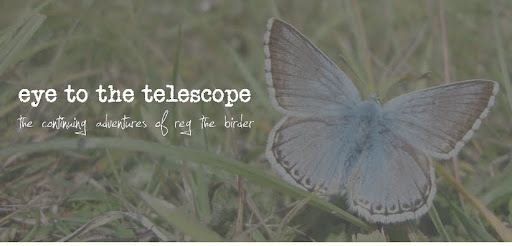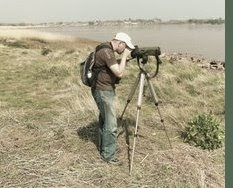On Sunday morning, I had the pleasure of watching a pair of lapwings getting jiggy with it in the magic field that I mentioned last time, thus confirming that they are indeed breeding here. I spotted five birds in the area this week, and it'll be interesting to follow their progress over the next few months.
The patch was extremely productive and I connected with the two species that I had hoped to see, chiffchaff and yellowhammer. I think I have been unfortunate not to have spotted yellowhammer already, as they are regular birds in the fields along Watery Lane, just a bit further on from Weatheroak. I saw several on Sunday in this spot, but the first ones I had were a pair just down from the magic field. I've heard them around here before, but never seen them, so this was very pleasing.
I glimpsed my chiffchaff along Watery Lane too. First I heard the familiar call, then spotted a small bird fly to a group of trees behind me. It was too distant to ID with the bins, but I didn't have to wait long for it to sing again and reveal its identity.
At least three or four more chiffchaffs were heard during my walk, plus many other decent sightings, such as fieldfare, rook, stock dove, bullfinch, cormorant, great spotted woodpecker, jay and little owl. A green woodpecker and a skylark were heard not far from the magic field, the latter being a bird that I have not yet seen on the patch this year. My next target, perhaps?
I took a series of photographs this morning, though without the aid of the scope, most of the subjects were somewhat distant. I have therefore decided to omit them. It's always difficult to take the scope with me on the patch, so I might try my hand at taking photos through the binoculars next time.
Birds Seen On Foot 2009: 61
Distance travelled: 51.9 miles
I need 14 more species in order to hit my target of 75 for the year. By my calculations, this could be a pretty close run thing. I'm planning to visit Earlswood Lakes again next week and I'm hopeful that this will net me a few goodies.
Islay
Last Thursday we had our final Islay meeting, where we planned our itinerary for the week that we will be spending on the island. We will arrive on Friday 22 May and depart on Sunday 31 May. Whilst we are planning to visit at least four or five distilleries, we have also lined up some quality birding during our stay.
As you'd expect, we will be having another try for the elusive corncrake. I really wouldn't like to say whether we'll be fortunate enough to see this bird, but it would be great just to hear it again. Of the others, I really hope that we get to see golden eagle, chough, pure rock doves, black guillemot and a few divers. There is also a good chance of Arctic skua, a species that I have yet to see.
One thing's for sure - it's going to be an amazing trip, and with less than eight weeks to go, I can't wait!
Wood You Believe It?
I'll be back in the Wyre Forest come May, looking for more new arrivals. With this in mind, I was glancing back through my records to see when I saw my first ever wood warbler, at Shenstone in 2007. It turns out it was on 15 April. There's an article in this month's Bird Watching magazine that says you won't get a sniff of a wood warbler until late April, which made me appreciate how lucky I was to uncover that one so early on in the month.
One of my goals this year is to see pied flycatcher in the Wyre. I reckon the window of opportunity for seeing these birds is pretty small, based on the number of times I dipped on it in 2008, both in the Wyre and in Wales.
I don't want to get ahead of myself, though. I'm sure April will bring its own crop of good birds and I'll be keen to see as many as I can. If one or two of them turn up on the patch, then don't be surprised to see me doing cartwheels down the streets of Wythall!
Monday, March 30, 2009
Monday, March 23, 2009
Could It Be Magic?
There's a field on my patch at the corner of Chapel Lane and Hill Lane, not far from St Mary's Church. As an inexperienced birder, I remember spotting either skylarks or meadow pipits in it some years ago. I can't recall enough detail to pin down what they were, save for the fact that they delivered their song in flight, before falling back down into the grass. Since then, I've always referred to it as the magic field.
On Saturday, as I walked around the patch, the magic field delivered the goods once more. I always keep an eye out for lapwings here, a bird that seems to be present in variable numbers during the breeding season. Whilst scanning the field, I was certain I had heard the call of a lapwing, but I couldn't pick any out. Suddenly, one popped up and once I had it in the bins, I could see another one behind it. Two quickly became three, then four, then five, then six.
These are actually the first lapwings I have seen on the patch this year. I'd expected to bump into them quite early on, but I just never connected with them. I shall be keeping close tabs on them over the coming months to see if my suspicion that they breed in this area is correct.
The only other bird of note was a lesser redpoll in Brick Kiln Lane, just a few hundred yards from my house. Funnily enough, I was actually looking for siskins, which I am convinced I could hear in the treetops, but despite scanning patiently for a few minutes, the redpoll was the only thing I could see.
I had hoped to hear chiffchaffs on the patch this weekend, but none were present. Maybe next week?
The ticks and the miles are building up nicely now. Here are the scores on the doors ...
Birds Seen On Foot 2009: 59
Distance travelled: 45.4 miles
Dipping In The Wyre
On Sunday, I had another stroll through the Wyre Forest. I failed to connect with one or two target species, but did see some siskin, a great spotted woodpecker, at least one dipper, two grey wagtails and a pair of kingfishers. I got my bins onto my first chiffchaff of the year, which wasn't too difficult as there were several birds present and they were all typically vocal.
My second butterfly of the year was seen along Dowles Brook, but once again I was unable to see enough of it to determine what it was.
Good Willow Hunting
I think I'll have to devote the next couple of weekends to scouring the patch for migrants. I've never seen wheatear or willow warbler around the lanes that I traditionally cover, but if I'm ever going to find them, now is the time. The farmland around Weatheroak and Hopwood looks a likely spot for the former species, and although my chances of success are probably minimal, it's got to be worth a look. This is also a good site for yellowhammer, another notable absentee from my list.
Last year I saw willow warblers at both Bittell Reservoir and Earlswood Lakes, so this is one that I should be able to tick with a bit of luck.
My target of 75 species on the patch this year still looks achievable, but I'm taking nothing for granted and the next few weeks could be crucial. If I can bag one or two scarcer birds during this time then I can probably afford to have a more leisurely summer, and focus a bit more on trying to find and ID a few butterflies. Only time will tell.
On Saturday, as I walked around the patch, the magic field delivered the goods once more. I always keep an eye out for lapwings here, a bird that seems to be present in variable numbers during the breeding season. Whilst scanning the field, I was certain I had heard the call of a lapwing, but I couldn't pick any out. Suddenly, one popped up and once I had it in the bins, I could see another one behind it. Two quickly became three, then four, then five, then six.
These are actually the first lapwings I have seen on the patch this year. I'd expected to bump into them quite early on, but I just never connected with them. I shall be keeping close tabs on them over the coming months to see if my suspicion that they breed in this area is correct.
The only other bird of note was a lesser redpoll in Brick Kiln Lane, just a few hundred yards from my house. Funnily enough, I was actually looking for siskins, which I am convinced I could hear in the treetops, but despite scanning patiently for a few minutes, the redpoll was the only thing I could see.
I had hoped to hear chiffchaffs on the patch this weekend, but none were present. Maybe next week?
The ticks and the miles are building up nicely now. Here are the scores on the doors ...
Birds Seen On Foot 2009: 59
Distance travelled: 45.4 miles
Dipping In The Wyre
On Sunday, I had another stroll through the Wyre Forest. I failed to connect with one or two target species, but did see some siskin, a great spotted woodpecker, at least one dipper, two grey wagtails and a pair of kingfishers. I got my bins onto my first chiffchaff of the year, which wasn't too difficult as there were several birds present and they were all typically vocal.
My second butterfly of the year was seen along Dowles Brook, but once again I was unable to see enough of it to determine what it was.
Good Willow Hunting
I think I'll have to devote the next couple of weekends to scouring the patch for migrants. I've never seen wheatear or willow warbler around the lanes that I traditionally cover, but if I'm ever going to find them, now is the time. The farmland around Weatheroak and Hopwood looks a likely spot for the former species, and although my chances of success are probably minimal, it's got to be worth a look. This is also a good site for yellowhammer, another notable absentee from my list.
Last year I saw willow warblers at both Bittell Reservoir and Earlswood Lakes, so this is one that I should be able to tick with a bit of luck.
My target of 75 species on the patch this year still looks achievable, but I'm taking nothing for granted and the next few weeks could be crucial. If I can bag one or two scarcer birds during this time then I can probably afford to have a more leisurely summer, and focus a bit more on trying to find and ID a few butterflies. Only time will tell.
Thursday, March 19, 2009
Nine To Five
I'm loving this Twitter lark! For those who have been following my tweets via the blog, or directly on the Twitter site, you'll know that I've had some reasonable sightings at home and at work during the week. Twitter allows me to post brief details of these spots in real time, which means no one has to hang around waiting for a full blog entry in order to catch up with the news.
Today, I thought I'd provide a bit more detail regarding some of my tweets during the week, focussing mainly on the birding I have managed to squeeze in at work.
However, I'll start off with the presumed lesser redpoll that flew over the house on Tuesday morning. I say presumed because I am not overly familiar with the call. However, on Sunday morning I had the privilege of watching about half a dozen of these birds at Upton Warren. It was the first time I had really listened to their distinctive nasal chatterings. Anyway, that was the sound I believe I heard as this small bird flew over the house a couple of days later. Despite this, I wouldn't rule out the chances of the bird being a siskin, but as both species already feature on my patch list this year, I won't be losing any sleep over it!
The arrival of spring always results in one or two changes to my routine at work. For starters, I have begun parking around the back of the building each morning. Why? Well, this is where the first chiffchaffs turn up. I've heard chiffchaff at a couple of sites already this year, but it will still be a special moment when I get the first one at work.
Secondly, the rising temperatures make me more inclined to take a stroll through the grounds during my breaks. It's debatable whether I will still be in the same job this time next year, so I have to take advantage of the beautiful surroundings whilst I can.
This week my walks have produced siskin, stock dove, song thrush, a few pied wagtails, one grey wagtail and some mistle thrush. Okay, I don't think I need to ask anyone to contain their excitement here, and I don't expect the site to be inundated with twitchers anytime soon, but in the context of the work environment these spots cheer me up no end.
I noticed a few birds amongst the pied wagtails on Wednesday. I'm afraid to say that I couldn't clinch ID with the naked eye, but I'm inclined to think they were meadow pipits. This would be a site first, so I'm keen to find them again and sort them out once and for all. The binnies will be coming to work with me today, so watch this space!
For now though, I'll leave you with a few shots of the grounds that surround the office and one or two comments about the species that I've notched up over the last few years.
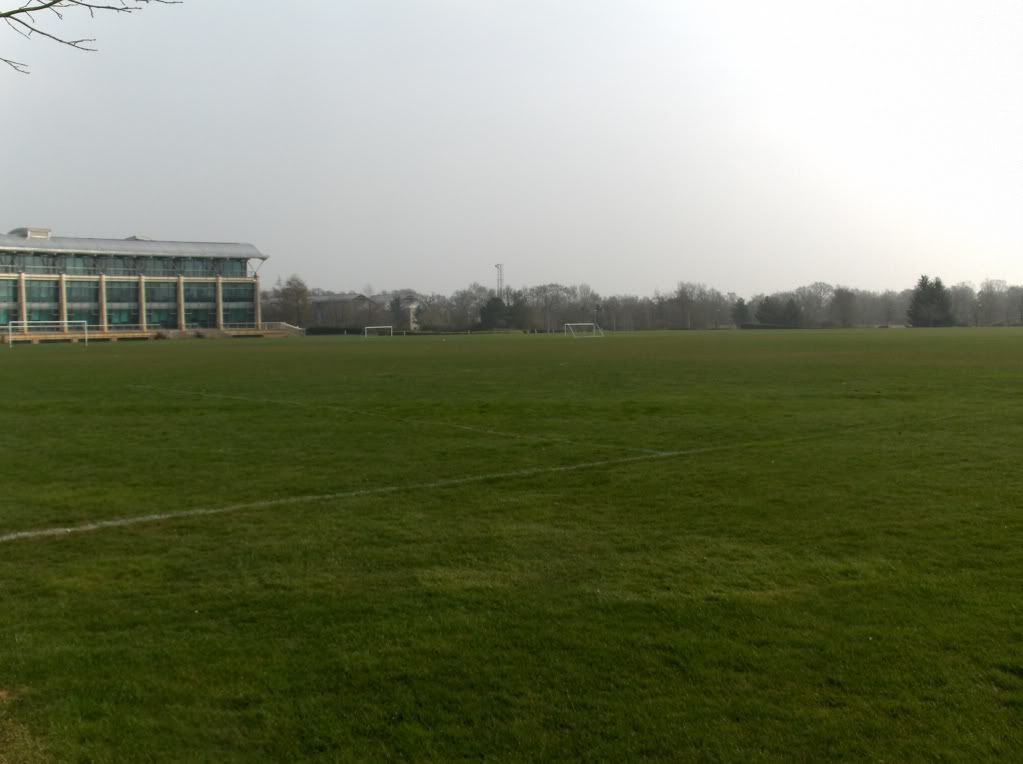
The football pitch - home to pied wagtails, the occasional grey wagtail, mistle thrush and redwing in the winter. A kestrel was regularly seen perching on the goal posts this winter.

The pavilion car park - the best area for chiffchaffs, but other good records include bullfinch and green woodpecker.
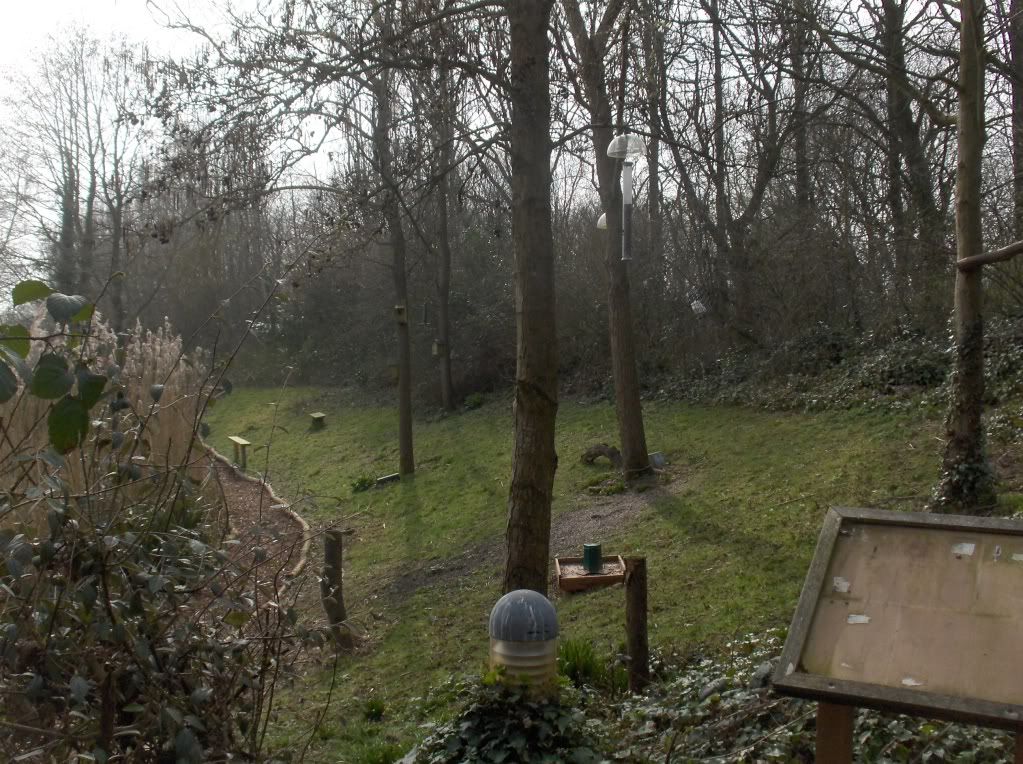
The feeding station - best spots include siskin, bullfinch, stock dove, goldfinch, nuthatch and great spotted woodpecker. Good for the butterflies too.
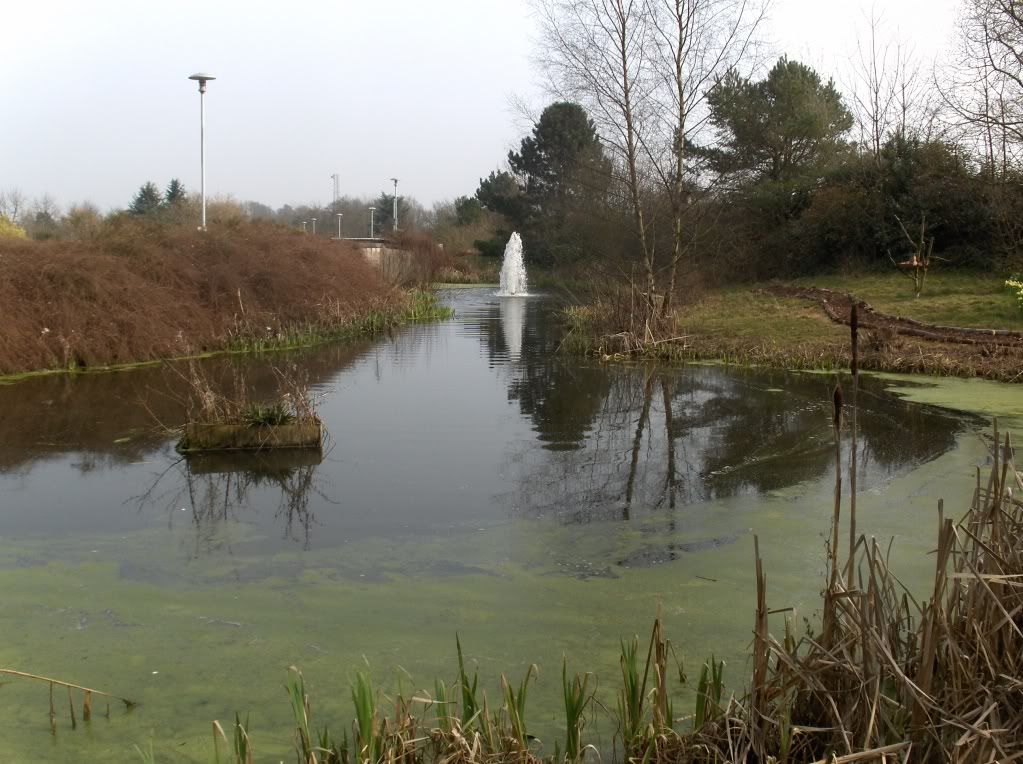
The small pond by the feeding station - good for the odd dragonfly or two.
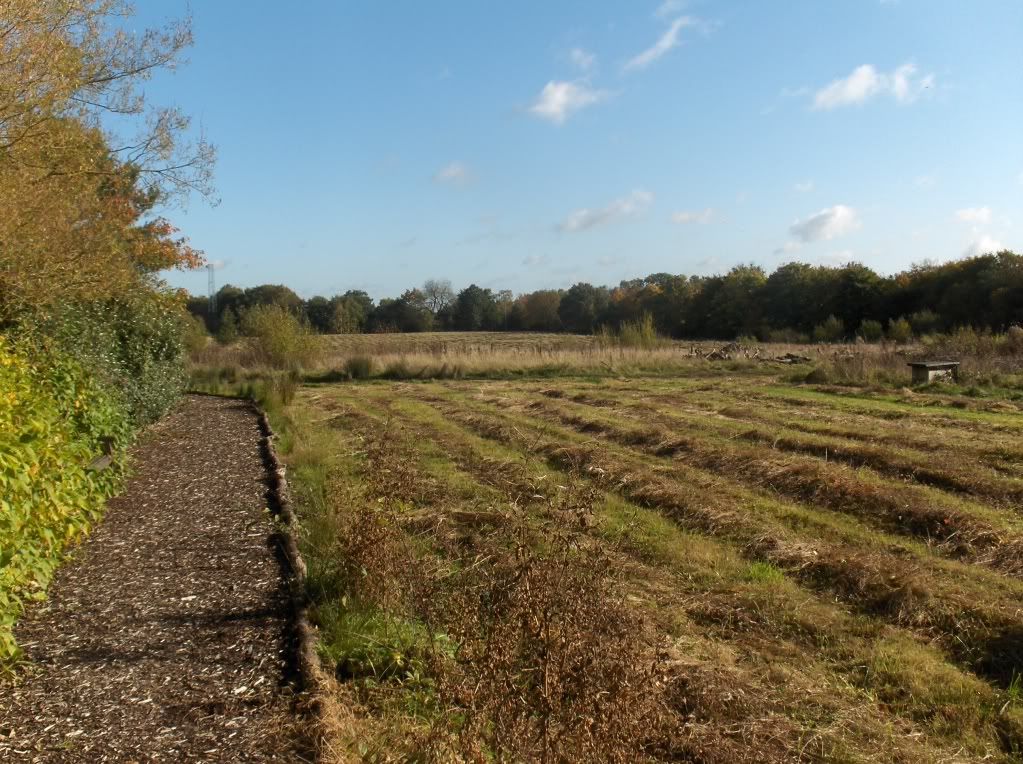
The meadow - jay, green woodpecker and kestrel are all quite regular here. Excellent for butterflies, including comma, speckled wood, small skipper and gatekeeper. I'll be keeping a close eye on it this summer.
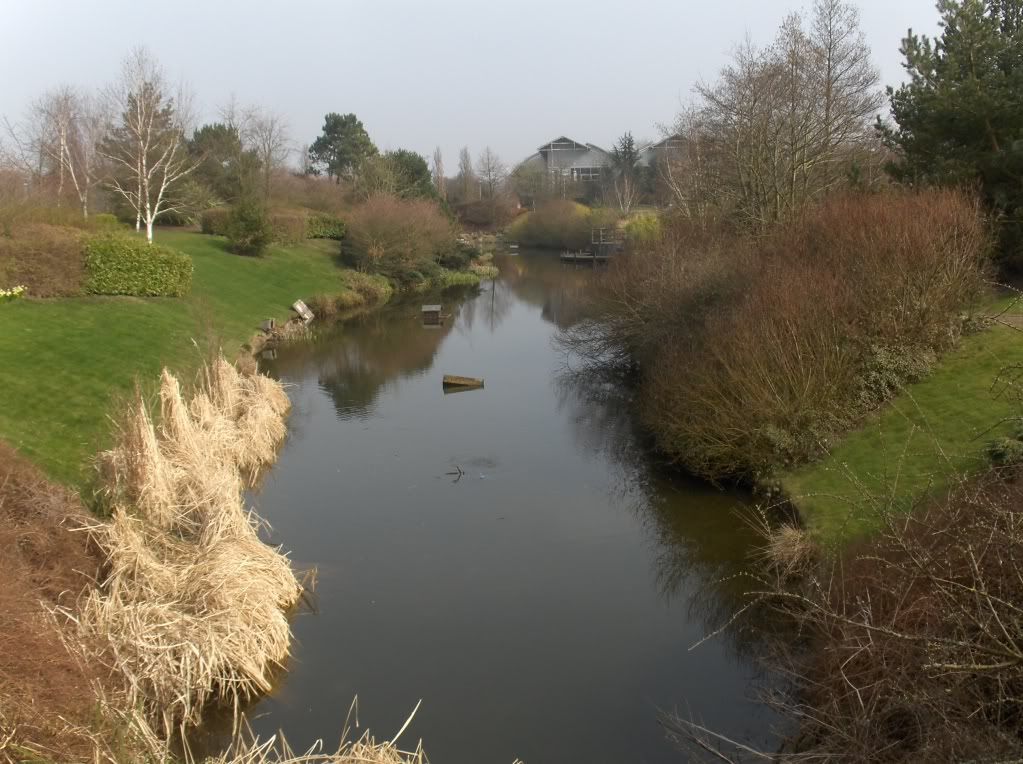
A kingfisher took up residence along this area about three years ago. It would be amazing if another one turned up.
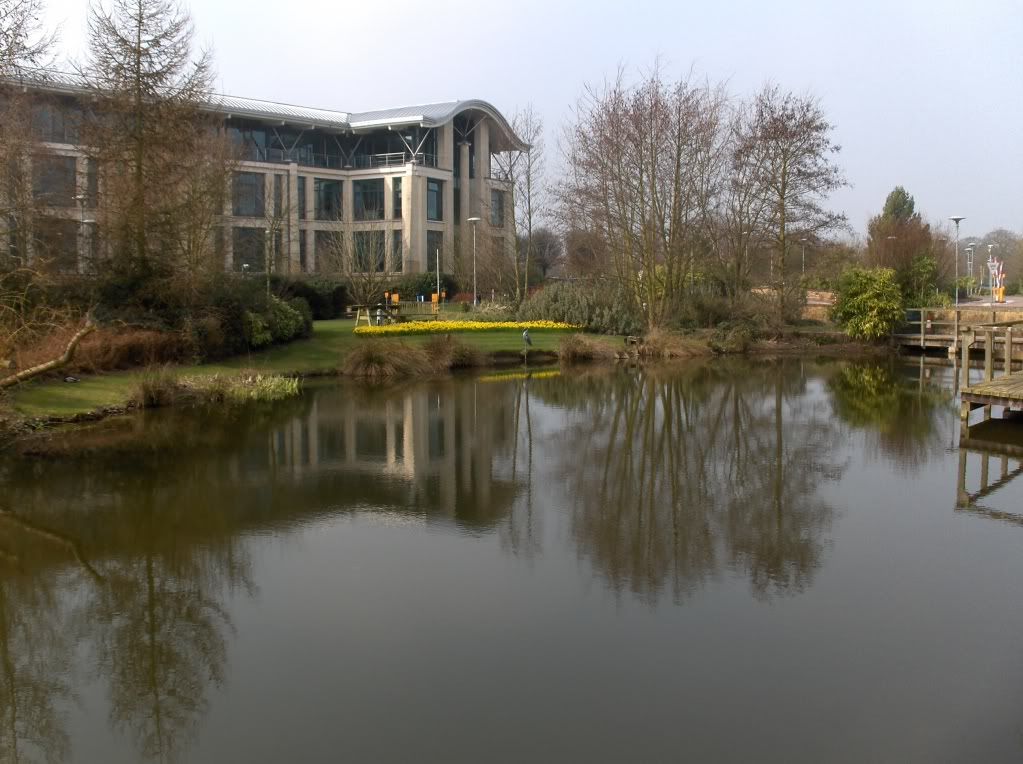
The wintering kingfisher was seen in this area too. During the summer, brown hawker and common darter dragonflies aren't uncommon here.
Other sightings of note over the past year include sparrowhawk, common buzzard, raven and red kite. Not a bad place to work, all things considered!
Today, I thought I'd provide a bit more detail regarding some of my tweets during the week, focussing mainly on the birding I have managed to squeeze in at work.
However, I'll start off with the presumed lesser redpoll that flew over the house on Tuesday morning. I say presumed because I am not overly familiar with the call. However, on Sunday morning I had the privilege of watching about half a dozen of these birds at Upton Warren. It was the first time I had really listened to their distinctive nasal chatterings. Anyway, that was the sound I believe I heard as this small bird flew over the house a couple of days later. Despite this, I wouldn't rule out the chances of the bird being a siskin, but as both species already feature on my patch list this year, I won't be losing any sleep over it!
The arrival of spring always results in one or two changes to my routine at work. For starters, I have begun parking around the back of the building each morning. Why? Well, this is where the first chiffchaffs turn up. I've heard chiffchaff at a couple of sites already this year, but it will still be a special moment when I get the first one at work.
Secondly, the rising temperatures make me more inclined to take a stroll through the grounds during my breaks. It's debatable whether I will still be in the same job this time next year, so I have to take advantage of the beautiful surroundings whilst I can.
This week my walks have produced siskin, stock dove, song thrush, a few pied wagtails, one grey wagtail and some mistle thrush. Okay, I don't think I need to ask anyone to contain their excitement here, and I don't expect the site to be inundated with twitchers anytime soon, but in the context of the work environment these spots cheer me up no end.
I noticed a few birds amongst the pied wagtails on Wednesday. I'm afraid to say that I couldn't clinch ID with the naked eye, but I'm inclined to think they were meadow pipits. This would be a site first, so I'm keen to find them again and sort them out once and for all. The binnies will be coming to work with me today, so watch this space!
For now though, I'll leave you with a few shots of the grounds that surround the office and one or two comments about the species that I've notched up over the last few years.

The football pitch - home to pied wagtails, the occasional grey wagtail, mistle thrush and redwing in the winter. A kestrel was regularly seen perching on the goal posts this winter.

The pavilion car park - the best area for chiffchaffs, but other good records include bullfinch and green woodpecker.

The feeding station - best spots include siskin, bullfinch, stock dove, goldfinch, nuthatch and great spotted woodpecker. Good for the butterflies too.

The small pond by the feeding station - good for the odd dragonfly or two.

The meadow - jay, green woodpecker and kestrel are all quite regular here. Excellent for butterflies, including comma, speckled wood, small skipper and gatekeeper. I'll be keeping a close eye on it this summer.

A kingfisher took up residence along this area about three years ago. It would be amazing if another one turned up.

The wintering kingfisher was seen in this area too. During the summer, brown hawker and common darter dragonflies aren't uncommon here.
Other sightings of note over the past year include sparrowhawk, common buzzard, raven and red kite. Not a bad place to work, all things considered!
Sunday, March 15, 2009
I Missed Again
Today's title refers to my attempts to photograph Cetti's warbler at Upton Warren this morning. If you'd asked me to predict whether I'd even clap eyes on this infamously elusive bird today, I would have almost certainly said no. However, I arrived at the East Hide at about 7:15am and didn't have to wait long before one popped up, perched out in the open and delivered its brilliant song.
I quickly realised that if it did that again, I could be in with a chance of a decent snap. Lo and behold, a few minutes later, up it popped again. However, by the time I'd got the scope in the right spot and the camera ready to roll, it had disappeared again. This happened a couple more times.
Finally, I saw something shoot up from the reeds and perch on a prominent branch in a nearby bush. This time I was ready. The scope was in place, the camera was at the ready and the bird delivered its song. Brilliant! It didn't leave its perch this time and I took advantage by reeling off several pictures.
Here's the result ...
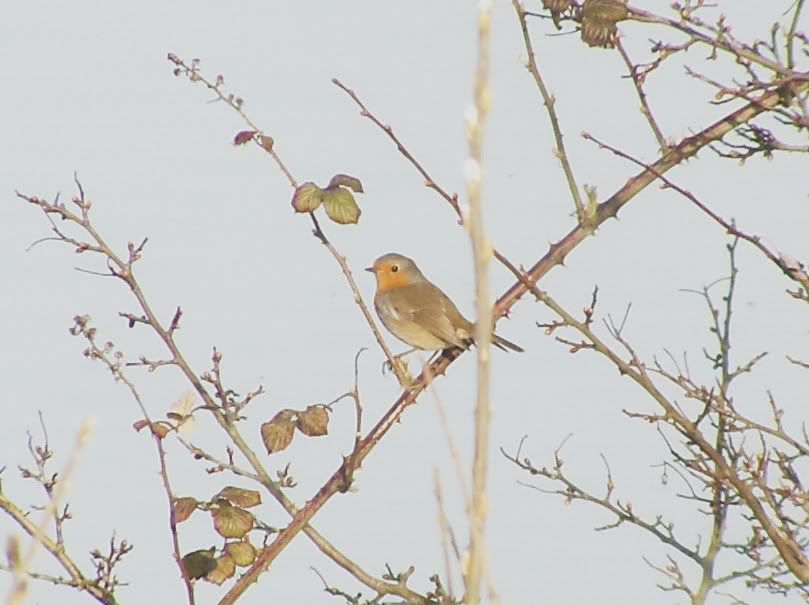
Bugger!
For any non-birders reading this, the above bird is not Cetti's warbler, though even the most inexperienced of you will probably have realised this! To anyone who is now doubting my birding credentials, can I point out that when digiscoping I don't always get a clear view of what I'm taking.
I can't complain. Photo or no photo, I feel very privileged to have had such good views of the correct species earlier in the day.
I did, however, manage to get a few decent pics of some other birds, which follow ...
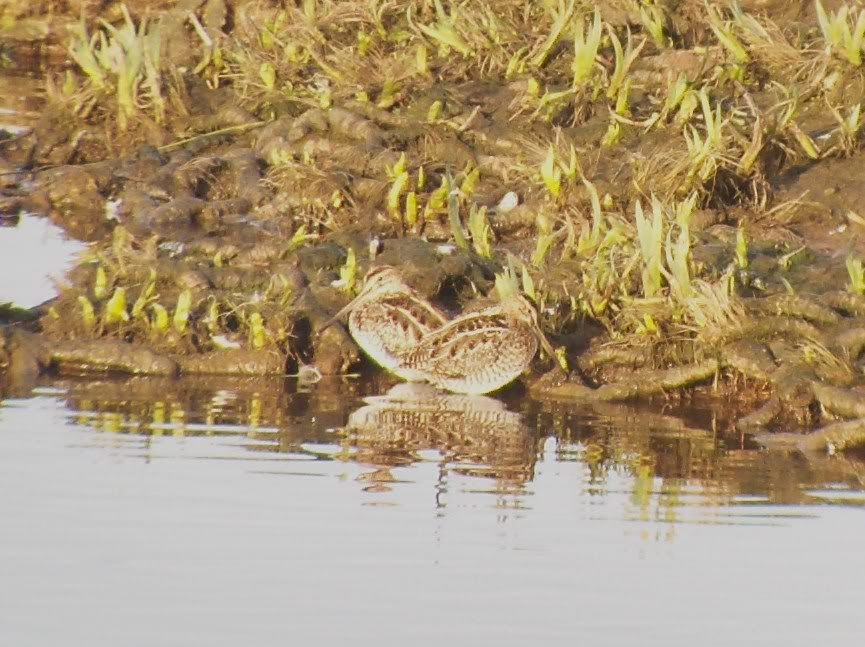
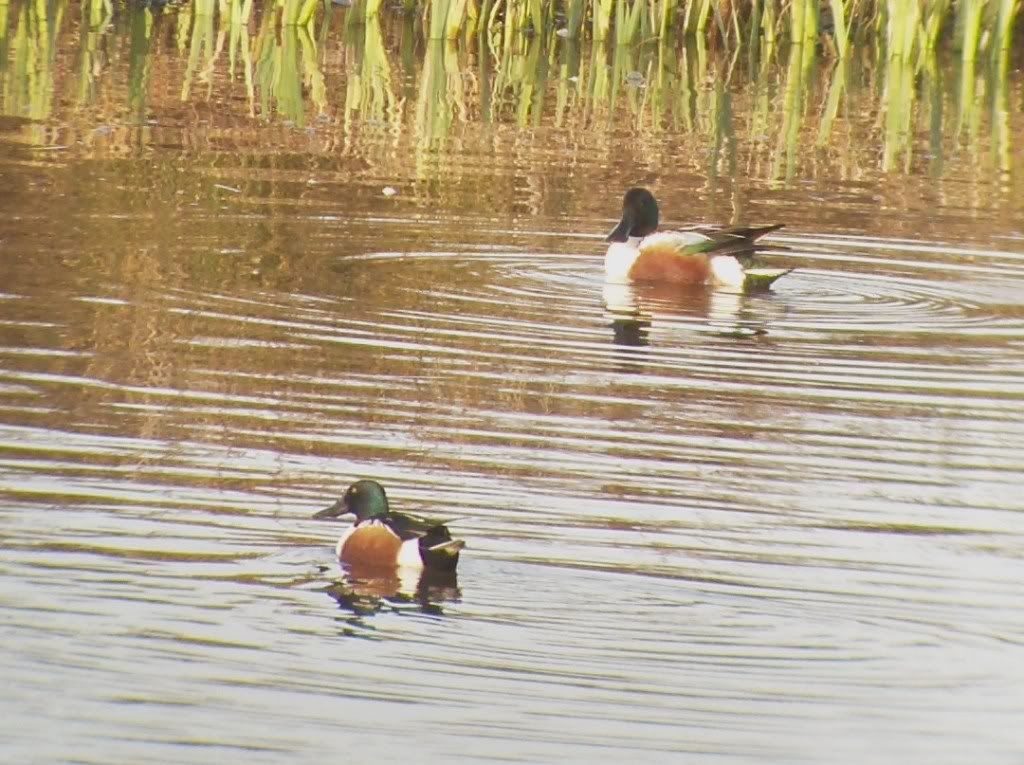

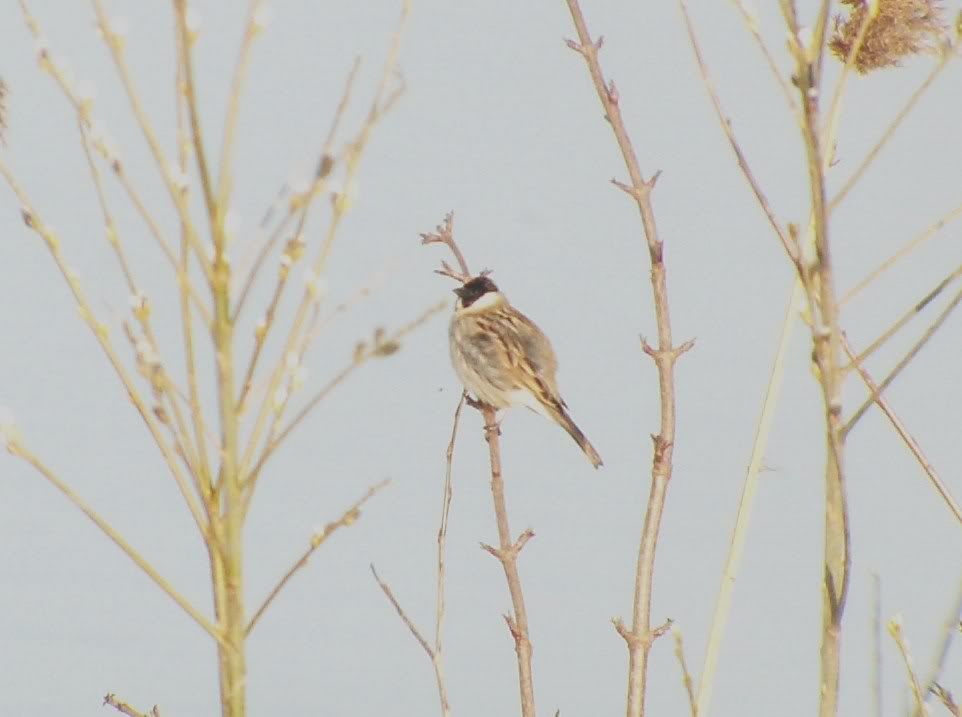
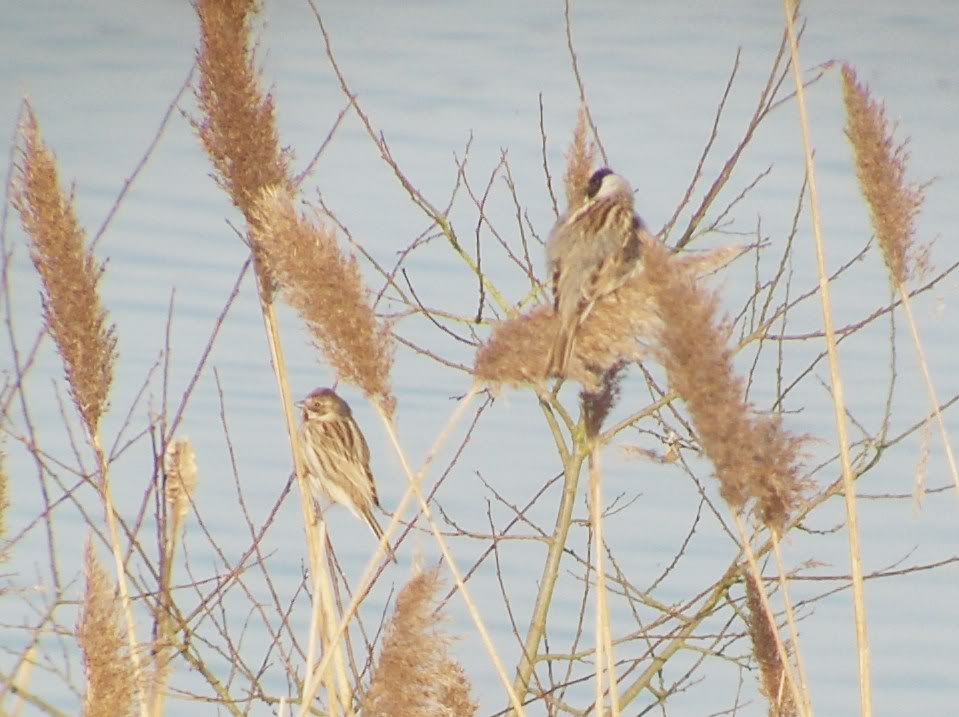

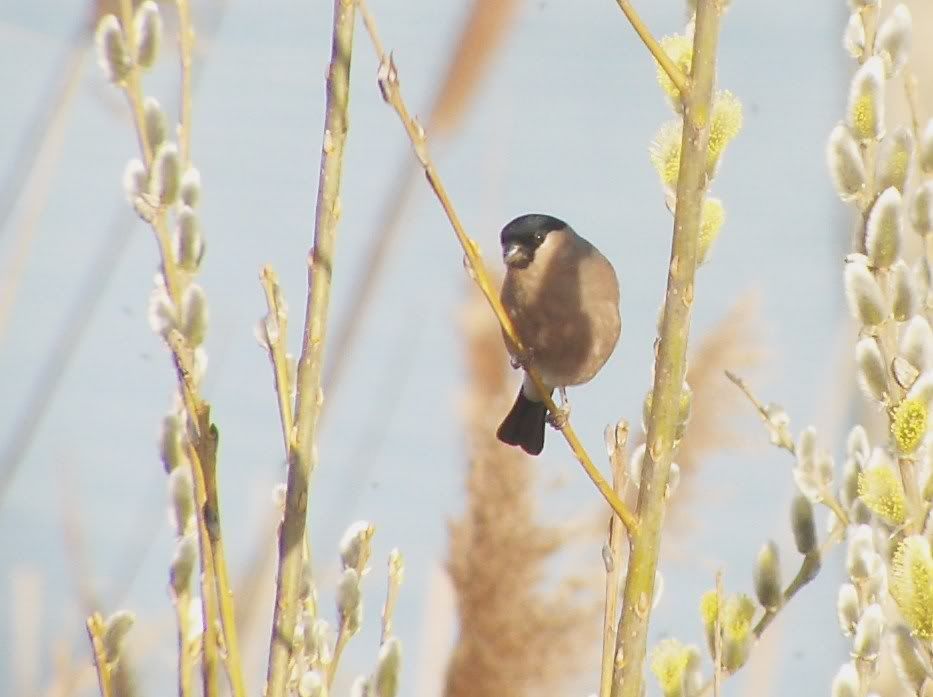
A bit later on I was joined by the Brightside Birders, Kay and Max. After leaving the East Hide, we paid a visit to the North Moors Pool and saw the remaining bittern, a water rail and a kingfisher. Over at the Flashes we spotted a peregrine on the masts and the three avocets that have been around for a bit.
Kay and Max headed off up the M6 in search of non-plastic barnacle geese, and I remained on the Flashes, conducting a lonely vigil for jack snipe, which ultimately proved unsuccessful.
Still, it was a beautiful morning, we saw some cracking birds, and when I got home I spotted my first butterfly of the year. I only caught a brief glimpse of it as it flew past my window, but I think it was a peacock.
I think it's official - spring has sprung!
I quickly realised that if it did that again, I could be in with a chance of a decent snap. Lo and behold, a few minutes later, up it popped again. However, by the time I'd got the scope in the right spot and the camera ready to roll, it had disappeared again. This happened a couple more times.
Finally, I saw something shoot up from the reeds and perch on a prominent branch in a nearby bush. This time I was ready. The scope was in place, the camera was at the ready and the bird delivered its song. Brilliant! It didn't leave its perch this time and I took advantage by reeling off several pictures.
Here's the result ...

Bugger!
For any non-birders reading this, the above bird is not Cetti's warbler, though even the most inexperienced of you will probably have realised this! To anyone who is now doubting my birding credentials, can I point out that when digiscoping I don't always get a clear view of what I'm taking.
I can't complain. Photo or no photo, I feel very privileged to have had such good views of the correct species earlier in the day.
I did, however, manage to get a few decent pics of some other birds, which follow ...







A bit later on I was joined by the Brightside Birders, Kay and Max. After leaving the East Hide, we paid a visit to the North Moors Pool and saw the remaining bittern, a water rail and a kingfisher. Over at the Flashes we spotted a peregrine on the masts and the three avocets that have been around for a bit.
Kay and Max headed off up the M6 in search of non-plastic barnacle geese, and I remained on the Flashes, conducting a lonely vigil for jack snipe, which ultimately proved unsuccessful.
Still, it was a beautiful morning, we saw some cracking birds, and when I got home I spotted my first butterfly of the year. I only caught a brief glimpse of it as it flew past my window, but I think it was a peacock.
I think it's official - spring has sprung!
Saturday, March 14, 2009
Get The Message
I'm still trying to get to grips with it, but I have added a feed from Twitter to the blog. I'm hoping to use this to provide quick, newsflash style birding updates as and when they happen, if I spot something good in the garden or at work for example.
The garden has produced some good birds lately. Aside from last week's peregrine, a few siskins have shown their faces during the month, and a goldcrest recently took a liking to the suet feeder. Not seen that before. Quite a few common buzzards are now putting in an appearance, happily cruising on the thermals until the local jackdaws see them off!
News of sand martins at Upton Warren has got me pretty excited. I'm planning to visit Earlswood Lakes on foot in a week or so, hopefully to pick up this species and possibly a couple of other early migrants. I'm not certain if I'll head out tomorrow though. I have big plans afoot. I don't want to say too much at this juncture, but it has something to do with Worcestershire Source.
As and when I have more information, I'll be sure to fill everyone in.
By the way, the Twitter feed seems to work best with Internet Explorer. If you use a different browser, you may experience difficulties with it.
The garden has produced some good birds lately. Aside from last week's peregrine, a few siskins have shown their faces during the month, and a goldcrest recently took a liking to the suet feeder. Not seen that before. Quite a few common buzzards are now putting in an appearance, happily cruising on the thermals until the local jackdaws see them off!
News of sand martins at Upton Warren has got me pretty excited. I'm planning to visit Earlswood Lakes on foot in a week or so, hopefully to pick up this species and possibly a couple of other early migrants. I'm not certain if I'll head out tomorrow though. I have big plans afoot. I don't want to say too much at this juncture, but it has something to do with Worcestershire Source.
As and when I have more information, I'll be sure to fill everyone in.
By the way, the Twitter feed seems to work best with Internet Explorer. If you use a different browser, you may experience difficulties with it.
Thursday, March 12, 2009
When Will I See You Again?
I was going through some photographs the other day. Amongst them were some snaps taken in Devon in April 2007. Mrs Reg and I had booked a long weekend in Dawlish Warren - one of our favourite destinations. I was still fairly new to what I would call hardcore birding - in fact, 2007 saw me make a proper year list for the first time, and the word lifer had only been in my vocabulary for about 12 months.
Armed with some excellent gen gathered from the internet, I was able to see my first Dartford warbler on Aylesbeare Common, and a cattle egret along the Otter Estuary was located without too much difficulty. I'm sure that cattle egrets will become easier to see over the next few years, but almost two years on I'm still waiting for my second one. I have a feeling, however, that I could be ticking this bird when I return to Devon in July this year.
You're Having A Laugh!
Another bird that I saw on that trip was a laughing gull that had been around the area for a week or two before we arrived. I was aware of its presence, but never thought that we would catch up with it. It just so happened that the gull decided to put in an appearance at Bowling Green Marsh on the Sunday morning. I would never have spotted it, but two chaps in the hide pointed it out when it dropped in.
I rattled off a few pictures at the time, but none seem to contain the gull in question. I recently put a request on the internet for a picture of this bird and was delighted when a gentleman by the name of Brian Heasman was able to oblige. Thanks for the use of the pic, Brian.

All of this reminiscing got me thinking about the rarer birds I have seen - particularly the ones that I might have to wait some time to see again, assuming I ever do of course!
The first that springs to mind is Wilson's phalarope. This bird turned up at Upton Warren on 23 September 2007, and in case you're wondering, I didn't need to look that date up - it will be etched on my mind for eternity! You can read a full write up of that memorable day at my old Surfbirds blog here. It could definitely be some time before I see another Wilson's phalarope, but as my old man still needs it I dare say we would twitch one if it wasn't too far away.
Next up is the American golden plover at Slimbridge in December 2007. This was another bird that I wouldn't have had a hope of seeing without the assistance of a few helpful birders in the Holden Tower. As you'd expect, the bird was with a sizeable flock of golden plover. Just as we got into position, something spooked the birds and they took off. When they settled again, one of the birders was somehow able to locate the American golden plover again, and I grabbed a quick look through his scope.
I saw the lesser scaup at Draycote Water twice - once in December 2007 and then again in January 2008. Therefore, the bird appears on two different year lists, but I think it still warrants inclusion here. It's another bird that seems to be turning up more regularly, however, so although it may involve a twitch, I'm sure I will see this one again at some point.
Bowled Over
Another Devon bird was the long-billed dowitcher, again at Bowling Green Marsh, in February 2008. I never saw the one that turned up at nearby Bittell Reservoir in 2006, but I think it was dipping on that one that triggered my interest in twitching for the odd rarity here and there. It was a great bird to get, and a bit of a milestone as it was my 200th lifer. On the same trip we also saw the surf scoter at Dawlish Warren. Although another bird has been present there this winter, I wouldn't like to say when I'll connect with one again.
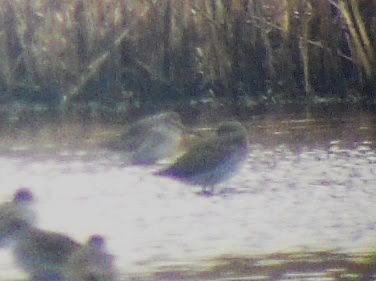
Looking through my 2008 year list, one or two more stick out like sore thumbs. It could be a long wait before I see green-winged teal, great skua, red-necked phalarope, Temminck's stint, black-winged stilt, ferruginous duck and ring-necked duck again. Going back to 2007, the spoonbill at Foryd Bay won't be an easy tick to repeat. On the other hand, I've got quite a few one-timers that I'm sure I will see again before too long. These include curlew sandpiper and pied flycatcher. I was going to include black grouse and ptarmigan, but then I remembered I saw both on two separate occasions in Scotland last year.
If The Bill Fits ...
The most controversial one on the list is Scottish crossbill. I had to bend the rules a bit when I ticked this last May. Whilst the birds showed enough features to suggest they weren't common crossbills, one can never be absolutely sure. It always makes me chuckle that people say you can't tell these species apart without analysing calls, but throw a picture of one on the internet and plenty will be immediately happy to say it is a common crossbill without a moment's hesitation! There seem to be a number of people who make it their personal mission to shoot down possible rarities on the forums, but I'll save that rant for another day.

I'll close by assuring you that I'm not trying to boast about the rarer birds I have seen, or to sound like some kind of expert on these matters. That's not how I get my kicks. In fact, whilst I take an interest in other people's birding, I dislike the competitive element that surfaces every so often. In my opinion, birding should be a pleasurable hobby, not a sport. I feel very privileged to have seen the birds I have and I'm sure most of you have seen many, many more. I actually envy those people that haven't got huge life lists, as they've got so much to look forward to.
As ever, enjoy your birding - whether you're looking at yet another blue tit, or getting up close and personal with Syke's warbler.
Armed with some excellent gen gathered from the internet, I was able to see my first Dartford warbler on Aylesbeare Common, and a cattle egret along the Otter Estuary was located without too much difficulty. I'm sure that cattle egrets will become easier to see over the next few years, but almost two years on I'm still waiting for my second one. I have a feeling, however, that I could be ticking this bird when I return to Devon in July this year.
You're Having A Laugh!
Another bird that I saw on that trip was a laughing gull that had been around the area for a week or two before we arrived. I was aware of its presence, but never thought that we would catch up with it. It just so happened that the gull decided to put in an appearance at Bowling Green Marsh on the Sunday morning. I would never have spotted it, but two chaps in the hide pointed it out when it dropped in.
I rattled off a few pictures at the time, but none seem to contain the gull in question. I recently put a request on the internet for a picture of this bird and was delighted when a gentleman by the name of Brian Heasman was able to oblige. Thanks for the use of the pic, Brian.

All of this reminiscing got me thinking about the rarer birds I have seen - particularly the ones that I might have to wait some time to see again, assuming I ever do of course!
The first that springs to mind is Wilson's phalarope. This bird turned up at Upton Warren on 23 September 2007, and in case you're wondering, I didn't need to look that date up - it will be etched on my mind for eternity! You can read a full write up of that memorable day at my old Surfbirds blog here. It could definitely be some time before I see another Wilson's phalarope, but as my old man still needs it I dare say we would twitch one if it wasn't too far away.
Next up is the American golden plover at Slimbridge in December 2007. This was another bird that I wouldn't have had a hope of seeing without the assistance of a few helpful birders in the Holden Tower. As you'd expect, the bird was with a sizeable flock of golden plover. Just as we got into position, something spooked the birds and they took off. When they settled again, one of the birders was somehow able to locate the American golden plover again, and I grabbed a quick look through his scope.
I saw the lesser scaup at Draycote Water twice - once in December 2007 and then again in January 2008. Therefore, the bird appears on two different year lists, but I think it still warrants inclusion here. It's another bird that seems to be turning up more regularly, however, so although it may involve a twitch, I'm sure I will see this one again at some point.
Bowled Over
Another Devon bird was the long-billed dowitcher, again at Bowling Green Marsh, in February 2008. I never saw the one that turned up at nearby Bittell Reservoir in 2006, but I think it was dipping on that one that triggered my interest in twitching for the odd rarity here and there. It was a great bird to get, and a bit of a milestone as it was my 200th lifer. On the same trip we also saw the surf scoter at Dawlish Warren. Although another bird has been present there this winter, I wouldn't like to say when I'll connect with one again.

Looking through my 2008 year list, one or two more stick out like sore thumbs. It could be a long wait before I see green-winged teal, great skua, red-necked phalarope, Temminck's stint, black-winged stilt, ferruginous duck and ring-necked duck again. Going back to 2007, the spoonbill at Foryd Bay won't be an easy tick to repeat. On the other hand, I've got quite a few one-timers that I'm sure I will see again before too long. These include curlew sandpiper and pied flycatcher. I was going to include black grouse and ptarmigan, but then I remembered I saw both on two separate occasions in Scotland last year.
If The Bill Fits ...
The most controversial one on the list is Scottish crossbill. I had to bend the rules a bit when I ticked this last May. Whilst the birds showed enough features to suggest they weren't common crossbills, one can never be absolutely sure. It always makes me chuckle that people say you can't tell these species apart without analysing calls, but throw a picture of one on the internet and plenty will be immediately happy to say it is a common crossbill without a moment's hesitation! There seem to be a number of people who make it their personal mission to shoot down possible rarities on the forums, but I'll save that rant for another day.

I'll close by assuring you that I'm not trying to boast about the rarer birds I have seen, or to sound like some kind of expert on these matters. That's not how I get my kicks. In fact, whilst I take an interest in other people's birding, I dislike the competitive element that surfaces every so often. In my opinion, birding should be a pleasurable hobby, not a sport. I feel very privileged to have seen the birds I have and I'm sure most of you have seen many, many more. I actually envy those people that haven't got huge life lists, as they've got so much to look forward to.
As ever, enjoy your birding - whether you're looking at yet another blue tit, or getting up close and personal with Syke's warbler.
Monday, March 9, 2009
It's Fate, Baby, It's Fate
Just before Christmas, our hot tap broke in the kitchen. A plumber came round, had a quick look at it and advised us that we'd probably be better off buying new taps. Not wishing to spend in excess of £100 unless absolutely necessary, I sought a second opinion from the chaps who came to fit our shower in January. They found that it was the cartridge that was faulty and thought we should be able to pick a new one up without too much difficulty and at minimal cost. Things are never that easy though, are they?
Over the next few weeks we called in at all the usual DIY stores, a couple of plumbers merchants and one or two other places - all to no avail. We decided to pay a visit to the people that originally supplied our kitchen, but the shop was closed and devoid of signs of life. It looks as though the credit crunch has claimed another victim.
Our final throw of the dice was the internet, and last Monday I managed to track down a supplier in Hampshire, who was prepared to send me the relevant part at a cost of £23.35 including post and packing. Not a snip by any means, but a better financial option than forking out for new taps. Buying stuff on the internet can be a bit of a punt at the best of times, but lo and behold, on Saturday morning the postman dropped a parcel through the letterbox containing the new part.
Just in case you think you have wandered onto the wrong blog, please be assured that this is Eye To The Telescope and, as such, there is a point to all this seemingly irrelevant water-themed waffle.
You see, with a few jobs lined up that day, I thought one more won't hurt and immediately set about fixing the tap. I was about 10 minutes into the job when I spotted a bird flying towards the house from the approximate direction of Wythall Station.
I instinctively knew it was a raptor and my head said sparrowhawk. But it wasn't - it was too big for starters, and the wings were all wrong. It was quite low, perhaps only 20 feet or so above the house. I could see blue markings on the face. It all happened in seconds, but I knew it was a peregrine.
I ran upstairs, hoping to see it from the bedroom window, tripping over the wire of Mrs Reg's curling tongs in the process. It took a few seconds to find the bird, as it was much further right than I had thought. As it disappeared, I saw enough of it to definitely rule out sparrowhawk, and it certainly wasn't a common buzzard. Then it wheeled left and I made a grab for the bins, but by the time I had got them and returned to the window, it was gone.
I played the situation out in my head afterwards and did my usual trick of trying to convince myself that it wasn't what I thought it was. No doubts remained though. Unsurprisingly, it's the first peregrine I've ever seen from the house and it has gained me not only a valuable patch tick, but a year tick too. I doubt if I will see it again.
Now I'm thinking if the tap hadn't broken and it hadn't taken so long to get the part, and if the part hadn't turned up on Saturday, and if I hadn't decided to fix it there and then, I probably would never have seen the bird! I suppose all birding hinges to some extent on fate and circumstance.
Sometimes you're just in the right place at the right time, and sometimes you're just in the wrong place at the wrong time. Once I was even in the wrong time at the right place - or am I thinking of that film with Michael J Fox in it?
Patch Work
Sunday morning saw me take a short walk through a fairly urban part of the patch. To be honest, it was pretty quiet and sprung few surprises. Aside from a few redwings, common buzzards and a sparrowhawk there was little to get excited about. Another attempt to see snipe in the pond near Wythall Park ended in failure.
I am eagerly anticipating the first appearance of a chiffchaff on the patch, surely only weeks away now. Spring is definitely in the air, but it hasn't yet touched down and collected its suitcase from the conveyor, if you know what I mean.
Telescope Points
Just when I had given up all hope, I received a correct entry for last week's quiz. Please be assured that no bias was shown when good friend and fellow Worcestershire Source collaborator Kay Donaghy took all 20 Telescope Points by correctly identifying cargoose as the answer to the following clue:
Vehicle goes over large bird – a crested grebe (8)
_ A _ G _ _ _ E
It turns out that cargoose is another word for a great crested grebe. You see, you don't just get silly tales about plumbing problems here on Eye To The Telescope - if you pay attention, you can learn something too!
Until next time, happy birding.
Over the next few weeks we called in at all the usual DIY stores, a couple of plumbers merchants and one or two other places - all to no avail. We decided to pay a visit to the people that originally supplied our kitchen, but the shop was closed and devoid of signs of life. It looks as though the credit crunch has claimed another victim.
Our final throw of the dice was the internet, and last Monday I managed to track down a supplier in Hampshire, who was prepared to send me the relevant part at a cost of £23.35 including post and packing. Not a snip by any means, but a better financial option than forking out for new taps. Buying stuff on the internet can be a bit of a punt at the best of times, but lo and behold, on Saturday morning the postman dropped a parcel through the letterbox containing the new part.
Just in case you think you have wandered onto the wrong blog, please be assured that this is Eye To The Telescope and, as such, there is a point to all this seemingly irrelevant water-themed waffle.
You see, with a few jobs lined up that day, I thought one more won't hurt and immediately set about fixing the tap. I was about 10 minutes into the job when I spotted a bird flying towards the house from the approximate direction of Wythall Station.
I instinctively knew it was a raptor and my head said sparrowhawk. But it wasn't - it was too big for starters, and the wings were all wrong. It was quite low, perhaps only 20 feet or so above the house. I could see blue markings on the face. It all happened in seconds, but I knew it was a peregrine.
I ran upstairs, hoping to see it from the bedroom window, tripping over the wire of Mrs Reg's curling tongs in the process. It took a few seconds to find the bird, as it was much further right than I had thought. As it disappeared, I saw enough of it to definitely rule out sparrowhawk, and it certainly wasn't a common buzzard. Then it wheeled left and I made a grab for the bins, but by the time I had got them and returned to the window, it was gone.
I played the situation out in my head afterwards and did my usual trick of trying to convince myself that it wasn't what I thought it was. No doubts remained though. Unsurprisingly, it's the first peregrine I've ever seen from the house and it has gained me not only a valuable patch tick, but a year tick too. I doubt if I will see it again.
Now I'm thinking if the tap hadn't broken and it hadn't taken so long to get the part, and if the part hadn't turned up on Saturday, and if I hadn't decided to fix it there and then, I probably would never have seen the bird! I suppose all birding hinges to some extent on fate and circumstance.
Sometimes you're just in the right place at the right time, and sometimes you're just in the wrong place at the wrong time. Once I was even in the wrong time at the right place - or am I thinking of that film with Michael J Fox in it?
Patch Work
Sunday morning saw me take a short walk through a fairly urban part of the patch. To be honest, it was pretty quiet and sprung few surprises. Aside from a few redwings, common buzzards and a sparrowhawk there was little to get excited about. Another attempt to see snipe in the pond near Wythall Park ended in failure.
I am eagerly anticipating the first appearance of a chiffchaff on the patch, surely only weeks away now. Spring is definitely in the air, but it hasn't yet touched down and collected its suitcase from the conveyor, if you know what I mean.
Telescope Points
Just when I had given up all hope, I received a correct entry for last week's quiz. Please be assured that no bias was shown when good friend and fellow Worcestershire Source collaborator Kay Donaghy took all 20 Telescope Points by correctly identifying cargoose as the answer to the following clue:
Vehicle goes over large bird – a crested grebe (8)
_ A _ G _ _ _ E
It turns out that cargoose is another word for a great crested grebe. You see, you don't just get silly tales about plumbing problems here on Eye To The Telescope - if you pay attention, you can learn something too!
Until next time, happy birding.
Tuesday, March 3, 2009
Set The Fire To The Third Bar
It makes a pleasant change to be spoilt for choice with today's song title. In recent weeks it has taken as long to find a suitable title as it has to write the blog entries themselves! It's almost tempting to go looking for species whose names lend themselves to well known tunes, just to make my life easier. If there was ever a good example of the tail wagging the dog, then I suppose this would be it.
But away with such nonsensical talk. Yesterday morning I headed in the direction of Coleshill to see the black redstart, followed by Hams Hall for the firecrest, both of which had been hanging around for a few weeks. The birds were located without too much difficulty, providing solid year ticks. In addition, we had a common sandpiper and a green sandpiper on the river near Hams Hall. Other birds of note included bullfinch, grey wagtail and several goldcrest.
A few chiffchaffs were heard singing in the bushes and trees near Hams Hall, but I wasn't overly worried about seeing one. In fact, it would have felt a bit like cheating if I had. I'm hoping to see this bird on the patch this month and I'm more than happy to wait for my tick.
My final sighting of note was Mr Max Silverman, photographer extraordinaire. Max's blog and pictures can be viewed here and is well worth a visit. I had intended to attach a few record shots of the black redstart to this report, but having taken another look at Max's excellent snaps of this bird, as well as the firecrest, I think you are probably much better off just visiting his site instead! For more superb pictures of the firecrest and other birds, I can highly recommend Dave Hutton's site too. I was truly blown away by the detail in some of Dave's images.
My Dad and I also paid visits to Shustoke Reservoir and Marsh Lane, but there were no exceptional sightings at either location. I'd hoped for tree sparrows at Shustoke, but none were seen. A few red-legged partridges were spotted in the fields neighbouring the reservoir, plus a pied wagtail that looked to me to have good credentials for a white wagtail. I'm far from experienced with this subspecies, however, and it does seem a bit early in the year to be thinking about seeing them, so a question mark remains over its identity. I've since done some swotting up, so the next time I see one I'll be armed and ready.
At Marsh Lane, the best sight was seven or more common buzzards and a single raven circling high up in the sky. We thought we spotted a peregrine up there too, but we weren't absolutely sure. Otherwise, the lane bordering the reserve was very quiet, although I remain convinced I heard a yellowhammer call a couple of times as we headed back to the car.
The Patch
On Sunday afternoon I had a pleasant, binocular-free walk around the lanes with Mrs Reg. Best of the birds were three ravens, seen in the fields near St Mary's Church, which nudged the patch count up by one. It's been a couple of weeks since I did any intensive patch birding, so I am looking forward to a wander through the lanes and fields of Wythall next weekend.
I've notched up a few species now and still hope to get the total up to 75 by the end of the year.
Birds Seen On Foot 2009: 57
Distance travelled: 38.9 miles
Telescope Points
This week's quiz comes from the Sunday Times crossword again. At the time of writing, I haven't cracked this clue, so I think it merits an award of 20 Telescope Points for the first correct answer.
Vehicle goes over large bird – a crested grebe (8)
_ A _ G _ _ _ E
Get your thinking caps on, fellow birders!
But away with such nonsensical talk. Yesterday morning I headed in the direction of Coleshill to see the black redstart, followed by Hams Hall for the firecrest, both of which had been hanging around for a few weeks. The birds were located without too much difficulty, providing solid year ticks. In addition, we had a common sandpiper and a green sandpiper on the river near Hams Hall. Other birds of note included bullfinch, grey wagtail and several goldcrest.
A few chiffchaffs were heard singing in the bushes and trees near Hams Hall, but I wasn't overly worried about seeing one. In fact, it would have felt a bit like cheating if I had. I'm hoping to see this bird on the patch this month and I'm more than happy to wait for my tick.
My final sighting of note was Mr Max Silverman, photographer extraordinaire. Max's blog and pictures can be viewed here and is well worth a visit. I had intended to attach a few record shots of the black redstart to this report, but having taken another look at Max's excellent snaps of this bird, as well as the firecrest, I think you are probably much better off just visiting his site instead! For more superb pictures of the firecrest and other birds, I can highly recommend Dave Hutton's site too. I was truly blown away by the detail in some of Dave's images.
My Dad and I also paid visits to Shustoke Reservoir and Marsh Lane, but there were no exceptional sightings at either location. I'd hoped for tree sparrows at Shustoke, but none were seen. A few red-legged partridges were spotted in the fields neighbouring the reservoir, plus a pied wagtail that looked to me to have good credentials for a white wagtail. I'm far from experienced with this subspecies, however, and it does seem a bit early in the year to be thinking about seeing them, so a question mark remains over its identity. I've since done some swotting up, so the next time I see one I'll be armed and ready.
At Marsh Lane, the best sight was seven or more common buzzards and a single raven circling high up in the sky. We thought we spotted a peregrine up there too, but we weren't absolutely sure. Otherwise, the lane bordering the reserve was very quiet, although I remain convinced I heard a yellowhammer call a couple of times as we headed back to the car.
The Patch
On Sunday afternoon I had a pleasant, binocular-free walk around the lanes with Mrs Reg. Best of the birds were three ravens, seen in the fields near St Mary's Church, which nudged the patch count up by one. It's been a couple of weeks since I did any intensive patch birding, so I am looking forward to a wander through the lanes and fields of Wythall next weekend.
I've notched up a few species now and still hope to get the total up to 75 by the end of the year.
Birds Seen On Foot 2009: 57
Distance travelled: 38.9 miles
Telescope Points
This week's quiz comes from the Sunday Times crossword again. At the time of writing, I haven't cracked this clue, so I think it merits an award of 20 Telescope Points for the first correct answer.
Vehicle goes over large bird – a crested grebe (8)
_ A _ G _ _ _ E
Get your thinking caps on, fellow birders!
Subscribe to:
Posts (Atom)
